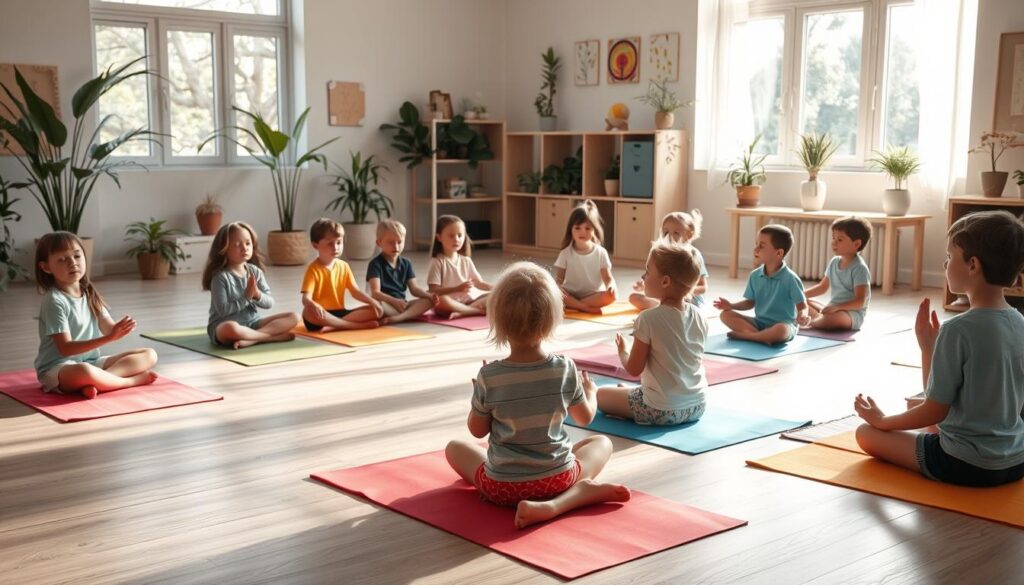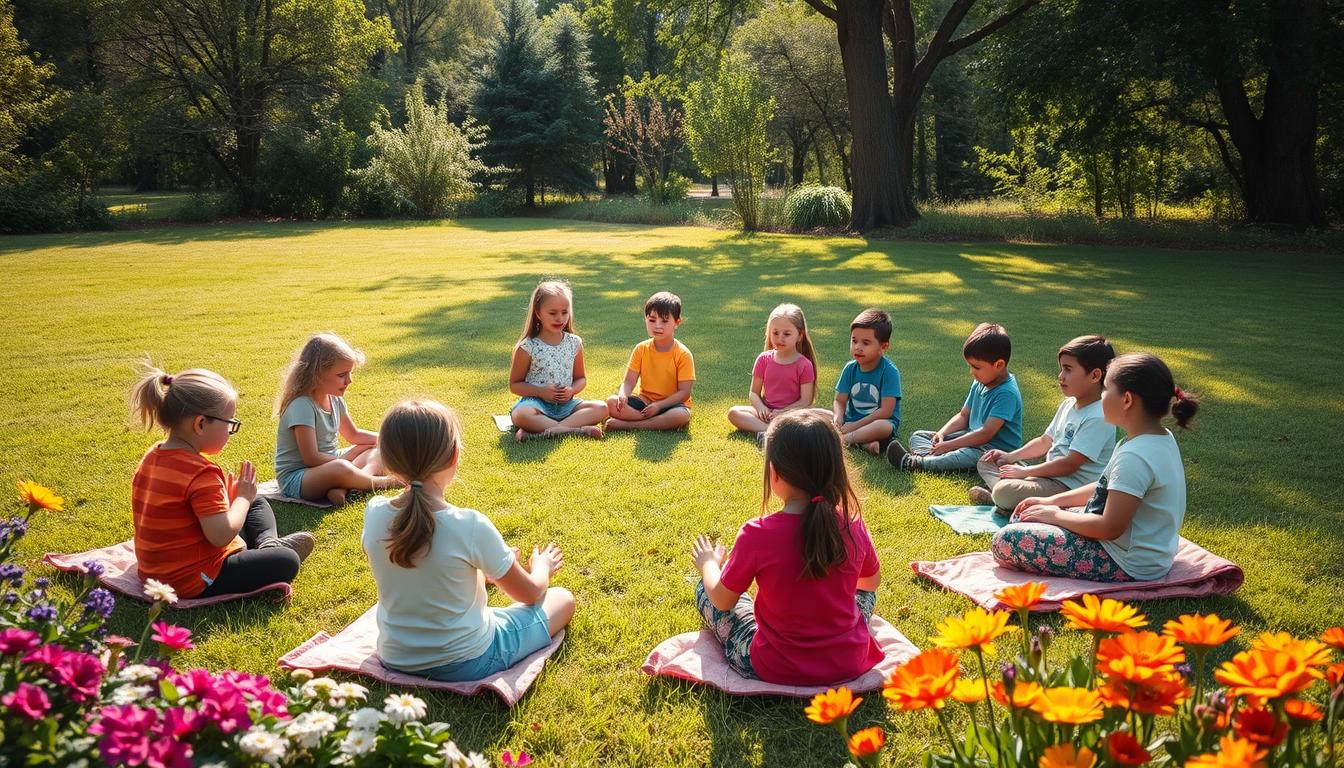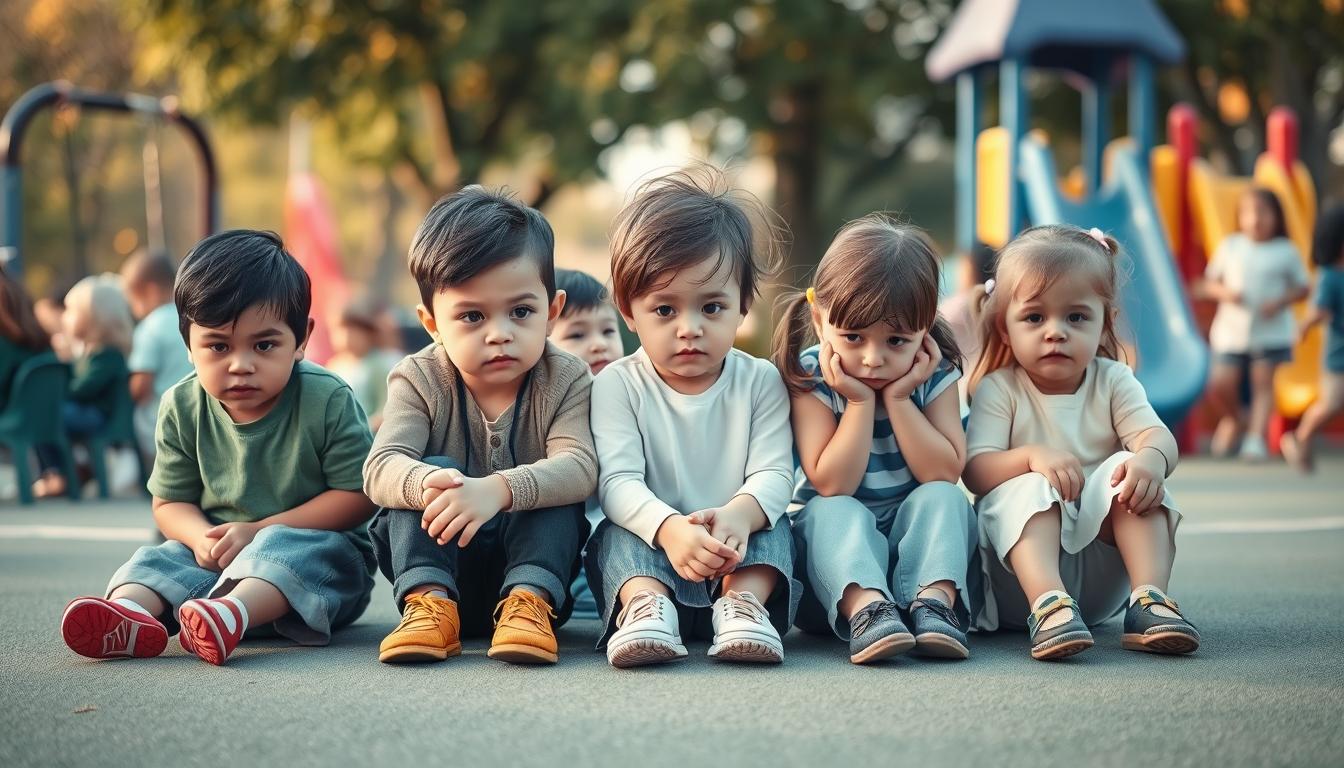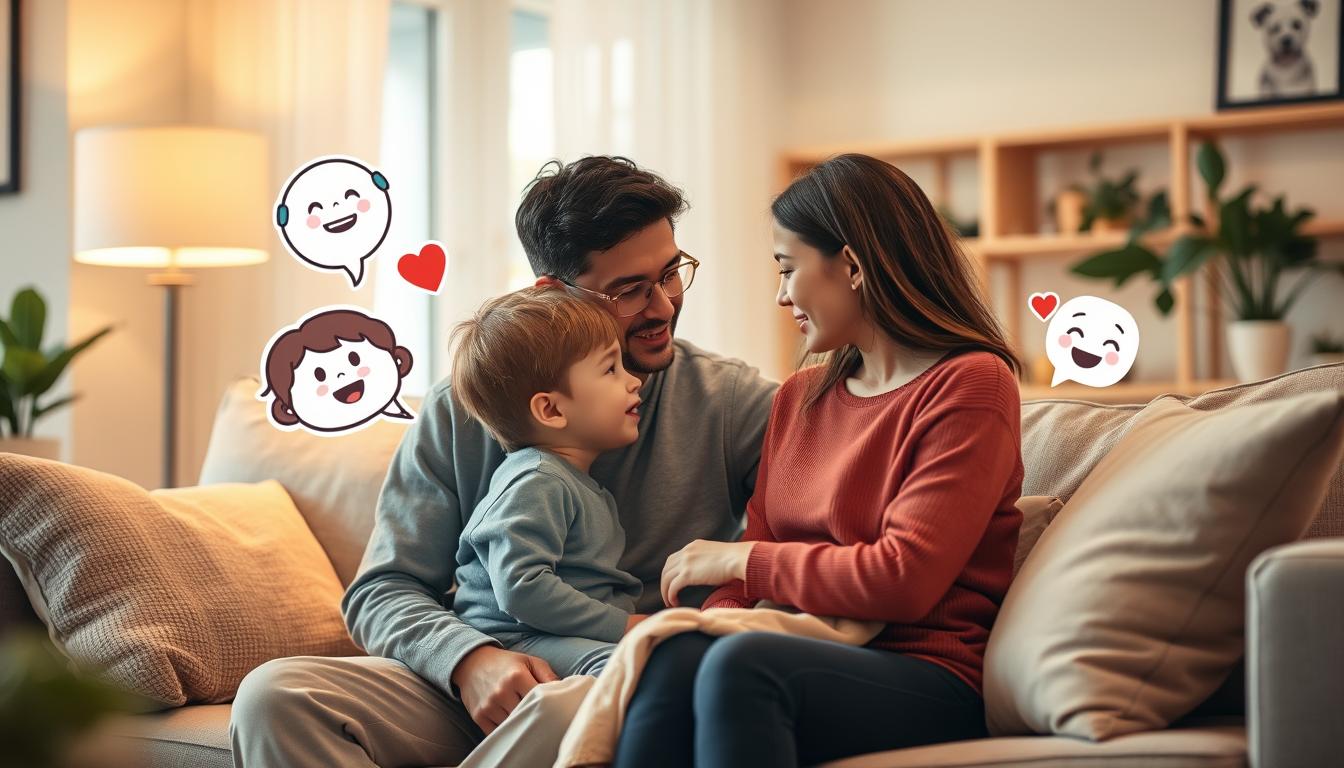Did you know that 1 in 6 children aged 2-8 years in the United States experiences a mental health disorder? This is a shocking fact that shows how important it is to help kids early. As a parent and wellness advocate, I’ve found that simple exercises can really help kids feel better and learn more (Mindfulness for Kids: Simple and Effective Exercises).
Mindfulness is more than just a trend. It’s a strong tool that helps kids deal with their feelings. By teaching kids mindfulness early, we give them the skills to handle stress, stay focused, and be emotionally strong.
My journey into mindfulness for kids started with seeing how it changes young minds. From breathing exercises to fun games, these activities teach kids to understand and control their feelings.
Key Takeaways
- Mindfulness can help children manage emotional challenges
- Early introduction of mindfulness supports mental health development
- Simple exercises can improve children’s focus and self-awareness
- Mindfulness is adaptable to different age groups
- Parent involvement enhances mindfulness practice effectiveness
Understanding the Basics of Child Mindfulness
Mindful parenting helps kids grow emotionally and become more aware of themselves. It’s not about making them mini-meditation experts. It’s about teaching them important life skills that help their emotional and mental growth.
Mindfulness for kids is different from how adults do it. Kids learn through play, getting involved, and using their senses. They have short attention spans, so we need creative ways to teach them to be present in the moment.
What Makes Mindfulness Unique for Children
- Shorter, more playful practice sessions
- Emphasis on sensory exploration
- Interactive and game-like learning methods
- Less structured, more intuitive approaches
Key Benefits of Early Mindfulness Practice
| Benefit Area | Developmental Impact |
|---|---|
| Emotional Regulation | Improved self-control and stress management |
| Cognitive Development | Enhanced focus and concentration |
| Social Skills | Better empathy and communication |
Creating the Right Environment for Practice
To help kids with mindfulness, we need a supportive and non-judgmental space. Parents and teachers should be calm, use language kids can understand, and make it feel like an adventure. Not a serious task.
“Mindfulness isn’t about perfection, it’s about connection – with ourselves and the world around us.” – Child Mindfulness Expert
Every child is different. We need patience, creativity, and gentle guidance to teach them mindfulness well.
Getting Started: Mindfulness for Kids: Simple and Effective Exercises
Teaching mindfulness to kids is easy. As a parent or teacher, I’ve found simple exercises can help a lot. They help kids understand their feelings and control their actions.
“Mindfulness is a superpower that helps children navigate their inner world with confidence and calm.” – Mindfulness Expert
Child mindfulness exercises change how kids deal with their emotions. Let’s look at some fun and helpful activities for kids.
- Body Scan Relaxation
- Mindful Listening
- Sensory Exploration
- Emotion Tracking
Here are some key techniques for teaching mindfulness to children:
| Exercise | Age Group | Duration |
|---|---|---|
| Finger Breathing | 4-7 years | 3-5 minutes |
| Cloud Watching | 6-10 years | 5-10 minutes |
| Heartbeat Meditation | 8-12 years | 5-7 minutes |
Remember, the key is to make these exercises playful and pressure-free. Kids learn best when activities feel like enjoyable games.
Mindful Breathing Techniques for Young Minds
Breathing is a powerful tool for kids to manage their emotions and grow self-aware. Mindful breathing exercises for kids can change how they see their feelings. It helps them stay calm and focused.
Children’s meditation doesn’t have to be hard. Simple, fun breathing techniques make mindfulness easy and enjoyable for young learners.
Bubble Breath Exercise
This fun breathing technique lets kids imagine their breath in a magical way:
- Ask children to imagine they’re blowing the most delicate soap bubble
- Breathe in slowly through the nose
- Exhale gently, as if creating a fragile bubble
- Focus on making the “bubble” as large and smooth as possible
“Breathing is the first act of life and the last. Our very life depends on it.” – Elizabeth Brown
Butterfly Breathing Method
This method turns breathing into a whimsical experience:
- Sit comfortably with hands on belly
- Imagine a butterfly landing on your stomach
- Breathe in, making the butterfly rise
- Breathe out, watching the butterfly gently flutter
Color Breathing Visualization
Color breathing makes mindful breathing a creative journey:
| Color | Breathing Focus | Emotional Impact |
|---|---|---|
| Blue | Calm, deep breaths | Relaxation |
| Green | Steady, balanced breathing | Healing |
| Yellow | Gentle, light breaths | Happiness |
Practice these mindful breathing exercises regularly to help children develop emotional resilience and inner peace.
Fun Movement-Based Mindfulness Activities
Yoga and mindfulness activities for kids turn physical movement into a mental wellness practice. They help kids connect their body and mind. This creates a whole approach to feeling and knowing themselves.
Here are some fun ways to introduce mindfulness through movement:
- Animal Walk Meditation
- Yoga Pose Challenge
- Mindful Dancing
- Freeze Dance Awareness
“Movement is a child’s language of expression and understanding” – Child Wellness Expert
Kids’ mindfulness activities that involve movement help them:
- Improve body awareness
- Develop concentration
- Release excess energy
- Learn emotional regulation
The key is making these activities playful and engaging. By turning yoga for kids into a fun game or challenge, they become more open to mindfulness.
| Activity | Age Group | Benefits |
|---|---|---|
| Animal Walks | 4-7 years | Coordination, Imagination |
| Yoga Poses | 6-12 years | Flexibility, Focus |
| Mindful Dancing | 5-10 years | Emotional Expression |
Remember, it’s not about being perfect but about participating. Encourage kids to explore movement with curiosity and joy.
Incorporating Mindfulness into Daily Routines
Mindful parenting turns everyday moments into chances for kids to be in the present. Daily routines are great for teaching kids to be aware and manage their feelings.
Starting mindfulness practices is easy. Small, thoughtful moments each day can greatly help a child’s emotional growth.
Morning Mindfulness Rituals
- Start the day with a 3-minute gratitude check-in
- Practice deep breathing together before breakfast
- Create a calm morning playlist
- Use gentle stretching as a mindful wake-up routine
Mindful Eating Practices
Make meal times mindful by using all your senses. Encourage kids to:
- Observe food colors and textures
- Chew slowly and enjoy the flavors
- Listen to the sounds of eating
- Thank the people who made the meal
Bedtime Relaxation Techniques
Evening routines can be great for mindfulness. Try these calming activities:
| Technique | Benefits |
|---|---|
| Body Scan Meditation | Reduces anxiety, improves sleep quality |
| Guided Visualization | Promotes emotional regulation |
| Gentle Breathing Exercise | Calms the nervous system |
“Mindfulness isn’t about perfection, it’s about connection – with ourselves and our children.”
By adding these simple habits, parents can help their kids feel better emotionally. They will also learn mindfulness skills that last a lifetime.
Teaching Present Moment Awareness Through Games

Kids mindfulness activities can turn learning into a fun adventure. It’s not hard to make mindfulness exciting for kids. I’ve found some great games that make it a blast!
The Freeze Game is a fantastic way to teach kids about being in the moment. When the music stops, players must freeze where they are. This game helps kids focus on their body and the present.
- Sound Mapping: Invite children to close their eyes and identify different sounds around them
- Sensory Scavenger Hunt: Encourage exploring immediate surroundings using all five senses
- Mirror Movement: Practice synchronized movements to build connection and awareness
“Mindfulness isn’t about perfection, it’s about paying attention” – Jon Kabat-Zinn
The Mindful Statue Challenge is another fun activity. Kids stand like statues, focusing on their breathing and body. It’s a game that makes mindfulness fun and helps with concentration and self-control.
By adding these fun activities, kids learn to enjoy the moment without judgment. The goal is to make these exercises feel like games, not lessons.
Mindful Art and Creative Expression
Art is a great way for kids to learn mindfulness. It helps them discover themselves and manage their feelings. Art makes learning mindfulness fun and exciting for young minds.
Creative activities are perfect for teaching kids mindfulness. They help kids stay present, focused, and aware of their feelings. Through art, kids can learn important skills about emotions.
Coloring Meditation Activities
Coloring meditation is a gentle way for kids to start learning mindfulness. It helps them:
- Stay focused on the present moment
- Develop fine motor skills
- Practice intentional breathing
- Reduce anxiety through repetitive motions
Mindful Drawing Exercises
Drawing can be a meditative activity for kids. They learn to watch their thoughts without judgment. Simple exercises like:
- Slow, deliberate line drawing
- Detailed pattern creation
- Emotion-based color selection
“Art allows children to explore their inner world with curiosity and compassion.” – Child Psychology Expert
Nature Art Projects
Art projects in nature boost mindfulness. Outdoor activities help kids connect with nature and their senses. Projects like leaf rubbings, rock painting, and nature collages make learning fun.
Remember, the goal is not perfection but presence. Every moment of art is a chance for kids to practice mindfulness. It helps them grow emotionally through creativity.
Using Mindfulness to Manage Big Emotions
Teaching mindfulness to kids is a great way to help them control their feelings. As a parent and mindfulness coach, I’ve seen how it changes a child’s way of dealing with tough emotions.
Teaching kids to manage their emotions is very important. It’s all about making a safe place where they can explore their feelings.
“Emotions are like waves. You cannot stop them, but you can learn to surf them.” – Unknown
Here are some ways to use mindfulness in parenting to help kids with big emotions:
- Create a calm, judgment-free space for emotional expression
- Teach children to recognize and name their emotions
- Practice deep breathing together during intense moments
- Use visualization techniques to help children process feelings
There are special mindfulness exercises that help kids understand their feelings better:
- Emotion Tracking: Encourage children to notice how emotions feel in their body
- Feeling Thermometer: Help kids rate and understand emotional intensity
- Mindful Listening: Practice active listening without immediate judgment
Mindful parenting isn’t about getting rid of feelings. It’s about teaching kids to feel them without getting too caught up. By doing these practices often, parents can help their kids become more resilient and aware of their emotions.
Mindfulness in the Classroom Setting
Teaching mindfulness to kids is key for today’s teachers. It helps students feel better and do better in school. Mindfulness gives students tools to handle school’s emotional and academic hurdles.

Mindfulness changes the classroom. It makes it a place where students can focus and feel calm. Students learn to know themselves and control their feelings better.
Engaging Group Activities for Classroom Mindfulness
- Guided group meditation sessions
- Breathing circle exercises
- Mindful listening challenges
- Collective body scan activities
Concentration Enhancement Strategies
Mindfulness boosts student focus. I suggest short, focused exercises to help students clear their minds:
- 5-minute silent reflection before lessons
- Mindful breathing breaks
- Sensory awareness games
- Visualization techniques
Stress Relief During Test Preparation
“Mindfulness is not about perfection, but about being present and aware.” – Educational Mindfulness Expert
Test anxiety is tough for students. Mindfulness teaches them to handle stress and do better on tests. Simple breathing and grounding techniques help a lot.
By adding mindfulness to schools, we create places that support both learning and feeling. It’s a win-win for students.
Parent-Child Mindfulness Bonding Activities
Mindful parenting is a great way to bond with your kids. It also teaches them to manage their emotions. Simple activities can turn everyday moments into special times that strengthen family ties.
Starting mindfulness practices doesn’t need to be hard. Easy, fun activities help parents and kids understand and connect with their feelings. They learn to be present in the moment.
- Silent Breathing Buddy Challenge: Choose a stuffed animal to place on your child’s stomach during breathing exercises
- Mindful Walk Adventure: Explore nature together, paying attention to sounds, textures, and sensations
- Emotion Check-In Ritual: Create a daily routine where you discuss feelings without judgment
- Gratitude Jar: Collect weekly moments of appreciation as a family
The key to successful mindful parenting is consistency and playfulness. Kids enjoy learning when it feels like a game, not a chore.
“Mindfulness is not about perfection, but about connection and awareness.” – Mindfulness Expert
| Activity | Age Group | Duration |
|---|---|---|
| Breathing Buddy | 3-7 years | 5-10 minutes |
| Nature Walk | 5-12 years | 15-30 minutes |
| Emotion Check-In | All ages | 10 minutes daily |
By using these mindful parenting methods, you’ll help your family grow emotionally. You’ll also strengthen your bond.
Age-Appropriate Meditation Techniques
Teaching mindfulness to kids needs a careful plan that fits their age. Meditation for children isn’t the same for everyone. Each age group needs special ways to connect with mindfulness.
Knowing how to start meditation changes a lot from preschool to tweens. Each age offers its own chance to practice mindfulness.
Preschool Meditation Methods
For little ones, meditation should be fun and short. Good ways to start include:
- Animal breathing exercises
- Sensory awareness games
- Short guided imagery sessions
Elementary School Practice Guide
Older kids can try more structured meditation. Here are some good methods for them:
- Visualization techniques
- Mindful movement activities
- Simple body scan practices
Tween Mindfulness Approaches
Tweens need more advanced ways to learn mindfulness. This should respect their growing independence.
| Age Group | Meditation Duration | Recommended Technique |
|---|---|---|
| Preschool (3-5) | 2-3 minutes | Storytelling meditation |
| Elementary (6-10) | 5-10 minutes | Guided breathing exercises |
| Tweens (11-13) | 10-15 minutes | Reflection and journaling |
“Mindfulness is a journey, not a destination. Each child’s path is unique.” – Mindfulness Expert
Patience and consistency are key when introducing meditation to children across different age groups.
Conclusion
Introducing mindfulness to kids is more than a trend. It’s a powerful way to help them grow emotionally and mentally. Simple exercises can help young minds become resilient, emotionally smart, and self-aware early on.
Exploring mindfulness shows how it can change kids’ lives. Activities like breathing exercises and creative play help them deal with stress and focus better. These skills are key in today’s fast world.
Parents and teachers are key in teaching mindfulness to kids. By supporting them and showing how it works, we help them learn to manage their emotions. The exercises we’ve talked about are more than quick fixes. They’re the start of a lifelong journey to well-being.
As we learn more about kids’ mental health, mindfulness stands out as a gentle yet strong method. By spending time on these practices, we’re not just teaching tricks. We’re raising a generation that’s emotionally smart, self-aware, and strong.



